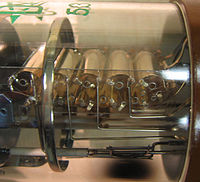
Photo from wikipedia
Infrared multiple photon dissociation spectroscopy was performed on protonated and cationized canavanine (Cav), a non-protein amino acid oxy-analog of arginine. Infrared spectra in the XH stretching region (3000 - 4000… Click to show full abstract
Infrared multiple photon dissociation spectroscopy was performed on protonated and cationized canavanine (Cav), a non-protein amino acid oxy-analog of arginine. Infrared spectra in the XH stretching region (3000 - 4000 cm-1) were obtained at the Centre Laser Infrarouge d'Orsay (CLIO) facility. Comparison of the experimental infrared spectra with scaled harmonic frequencies at the B3LYP/6-31+G(d,p) level of theory indicates that canavanine is in a canonical neutral form in CavH+, CavLi+, and CavNa+; therefore, these cations are charge-solvated structures. The infrared spectrum of CavK+ is consistent with a mixture of Cav in canonical and zwitterionic forms leading to both charge-solvated and salt-bridged cationic structures. The Cav moiety in CavCs+ is shown to be zwitterionic, forming a salt-bridged structure for the cation. Infrared spectra in the fingerprint region (1000 - 2000 cm-1) obtained at the FELIX Laboratory in Nijmegen, Netherlands support these assignments. These results show that that a single oxygen atom substitution in the side chain reduces the stability of the zwitterion compared to that of the protein amino acid arginine (Arg), which has been shown previously to adopt a zwitterionic structure in ArgNa+ and ArgK+. This difference can be explained in part due to the decreased basicity of Cav (PA = 1001 kJ/mol) as compared to arginine (PA = 1051 kJ/mol), but not entirely, as lysine, which has nearly the same proton affinity as Cav, (~993 kJ/mol) forms only canonical structures with Na+, K+, and Cs+. A major difference between the zwitterionic forms of ArgM+ and CavM+ is that the protonation site is on the side chain for Arg and on the N-terminus for Cav. This results in systematically weaker salt bridges in the Cav zwitterions. In addition, the presence of another hydrogen-bonding acceptor atom in the side chain contributes to the stability of the canonical structures for the smaller alkali cations.
Journal Title: International journal of mass spectrometry
Year Published: 2018
Link to full text (if available)
Share on Social Media: Sign Up to like & get
recommendations!